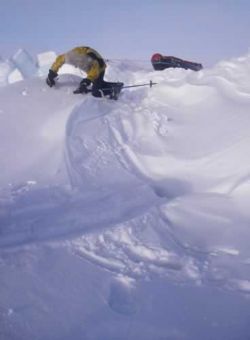Why?
Published on 15.06.2007 - The Arctic Arc
Here are the reasons explaining why the expedition The Arctic Arc had to stop along the coast of Greenland and not continue their journey to the south of the island as previously planned.
Before we start enumerating the reasons for this change of itinerary, we must first come back to the initial objectives of this great adventure and to the spirit in which the expedition was organized.
We remind you that the project, conceived within the framework of the International Polar Year, aimed to attempt an exceptional adventure which had no other goal than to allow further scientific research on our climate to be undertaken in northern latitudes, so that men could better understand the polar regions' environment.
The spirit of The Arctic Arc
The spirit which drove Alain Hubert to conceive this project was to come back to polar exploration and the idea of going where no man had ever dared to go before. This is how the journey Siberia â Greenland came about. The expedition was divided into three chapters of different importance: reaching the North Pole and linking Siberia to Greenland were the major stages of the expedition. As far as the Greenland crossing from north to south, this part of the adventure was more like the icing on the cake, and was never meant to be directly involved in the nature of the feat. We understand that as the initiators of the sail traction technique named "powerkite" (initiated during their Antarctic crossing in 1997-98), the two men now wanted to try the 2000 and some kilometres involved in crossing Greenland from north to south. Alain Hubert was nonetheless conscious that, in order for this tremendous race to happen, the adventure had to meet the best possible conditions. But, as we have seen throughout the journey, conditions did not live up to their expectations...
Two major reasons drove Alain Hubert to change his itinerary
First of all, there was the fact that the expedition was delayed throughout the journey. Never before, in any explorer's mind, had the meteorological conditions on the sea ice been so atrocious during this spring 2007 â a succession of storms completely shattering the ice's appearance and provoking an abundance of open water leads, a constant mist impeding on visibility beyond 100 metres, omnipresent compression zones along their trajectory (although these are normally present along the coasts), and an overly present snow cover slowing down the glide and forcing the two men to be extremely prudent. In order to better understand these tremendous conditions, it is good to read the reports written by the British explorer Rosie Stancer, who managed to reach the proximity of North Pole (she was forced to abandon at 150 km from NP) on account of incredible efforts and by progressing an average of only 7 or 8 km a day!
Then there was a bad stroke of fate. To the surprise of everyone, the Robeson Straight (near the Victoria Fjord along the expedition's original trajectory), through which they had to go in order to reach the Greenland plateau, did not freeze this past winter. This event coupled with the strong storms over the Arctic this past spring provoked a real upheaval in the Lincoln Sea. A U-bend effect pulled all the ice towards this area, causing huge dislocations all along the edges of the sea ice. The initial plan was destined for failure at 100%. Informed of this situation by the router, the two men therefore had to change their direction and head towards one of the only accessible zones of the Greenland coast. But, unfortunately the topography of this zone did not allow them to climb upon the polar plateau of the island. So, they therefore had to take the decision to stop the expedition there.
A better understanding of the polar environment
To conclude, Alain Hubert, together with the International Polar Foundation, would like to remind everyone that the main goal of the expedition was â as we have seen above â to attempt an exceptional adventure which would enable climate research to progress in the northern latitudes and allow as many people as possible to better understand the polar environment.
He adds that the snow thickness measurements that the expedition had to do for ESA were scrupulously done, at a rhythm of one measurement every four days. In this respect, Arctic Arc is already a huge success, since the expedition has participated in further understanding the physical characteristics of the Arctic sea ice which, according to researchers, is essential for fighting climate change on the long term.
The website of the Day
Here's another article from the National Geographic News, a little older this time. It was written by John Roach and published on December 1st, 2004: "Melting Arctic Bogs May Hasten Warming, Study Says".
The author explains in his lines that scientific studies have shown that the northernmost areas of the Siberian tundra absorb on the long run more carbon dioxide than that which it emits. But if the temperature of this biosphere continues to rise as it has been for the moment, it could lead to a real ecological disaster.











